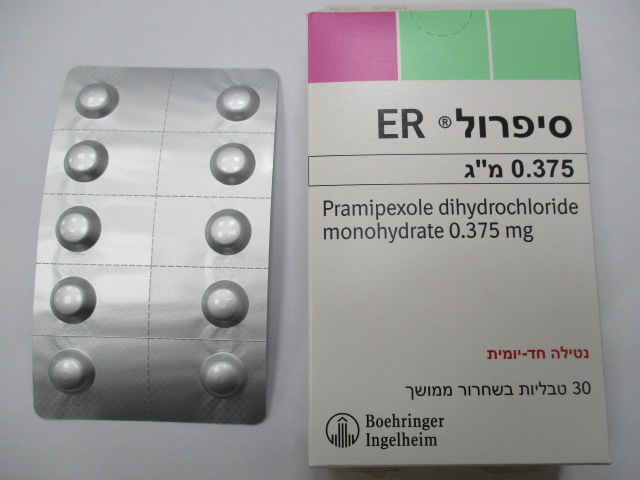Quest for the right Drug

סיפרול ER 0.375 SIFROL ER 0.375 mg (PRAMIPEXOLE DIHYDROCHLORIDE MONOHYDRATE)
תרופה במרשם
תרופה בסל
נרקוטיקה
ציטוטוקסיקה
צורת מתן:
פומי : PER OS
צורת מינון:
טבליות עם שחרור נרחב : TABLETS EXTENDED RELEASE
עלון לרופא
מינוניםPosology התוויות
Indications תופעות לוואי
Adverse reactions התוויות נגד
Contraindications אינטראקציות
Interactions מינון יתר
Overdose הריון/הנקה
Pregnancy & Lactation אוכלוסיות מיוחדות
Special populations תכונות פרמקולוגיות
Pharmacological properties מידע רוקחי
Pharmaceutical particulars אזהרת שימוש
Special Warning עלון לרופא
Physicians Leaflet
Posology : מינונים
4.2 Posology and method of administration Posology SIFROL extended-release tablets are a once-a-day oral formulation of pramipexole. Initial treatment Doses should be increased gradually from a starting dose of 0.375 mg of salt (0.26 mg of base) per day and then increased every 5 - 7 days. Providing patients do not experience intolerable undesirable effects, the dose should be titrated to achieve a maximal therapeutic effect. Ascending dose schedule of SIFROL extended-release tablets Week Daily dose (mg of salt) Daily dose (mg of base) 1 0.375 0.26 2 0.75 0.52 3 1.5 1.05 If a further dose increase is necessary the daily dose should be increased by 0.75 mg of salt (0.52 mg of base) at weekly intervals up to a maximum dose of 4.5 mg of salt (3.15 mg of base) per day. However, it should be noted that the incidence of somnolence is increased at doses higher than 1.5 mg of salt (1.05 mg of base) per day (see section 4.8). Patients already taking SIFROL tablets may be switched to SIFROL extended-release tablets overnight, at the same daily dose. After switching to SIFROL extended-release tablets, the dose may be adjusted depending on the patient’s therapeutic response (see section 5.1). Maintenance treatment The individual dose of pramipexole should be in the range of 0.375 mg of salt (0.26 mg of base) to a maximum of 4.5 mg of salt (3.15 mg of base) per day. During dose escalation in pivotal studies, efficacy was observed starting at a daily dose of 1.5 mg of salt (1.05 mg of base). Further dose adjustments should be done based on the clinical response and the occurrence of adverse reactions. In clinical trials approximately 5% of patients were treated at doses below 1.5 mg of salt (1.05 mg of base). In advanced Parkinson’s disease, pramipexole doses higher than 1.5 mg of salt (1.05 mg of base) per day can be useful in patients where a reduction of the levodopa therapy is intended. It is recommended that the dose of levodopa is reduced during both the dose escalation and the maintenance treatment with SIFROL, depending on reactions in individual patients (see section 4.5). Missed dose When the intake of a dose is missed, SIFROL extended-release tablets should be taken within 12 hours after the regularly scheduled time. After 12 hours, the missed dose should be left out and the next dose should be taken on the following day at the next regularly scheduled time. Treatment discontinuation Abrupt discontinuation of dopaminergic therapy can lead to the development of a neuroleptic malignant syndrome or a dopamine agonist withdrawal syndrome. Pramipexole should be tapered off at a rate of 0.75 mg of salt (0.52 mg of base) per day until the daily dose has been reduced to 0.75 mg of salt (0.52 mg of base). Thereafter the dose should be reduced by 0.375 mg of salt (0.26 mg of base) per day (see section 4.4). Dopamine agonist withdrawal syndrome could still appear while tapering and a temporary increase of the dose could be necessary before resuming tapering (see section 4.4) Renal impairment The elimination of pramipexole is dependent on renal function. The following dose schedule is suggested for initiation of therapy: Patients with a creatinine clearance above 50 mL/min require no reduction in daily dose or dosing frequency. In patients with a creatinine clearance between 30 and 50 mL/min, treatment should be started with 0.375 mg SIFROL extended-release tablets every other day. Caution should be exercised and careful assessment of therapeutic response and tolerability should be made before increasing to daily dosing after one week. If a further dose increase is necessary, doses should be increased by 0.375 mg pramipexole salt at weekly intervals up to a maximum dose of 2.25 mg of salt (1.57 mg pramipexole base) per day. The treatment of patients with a creatinine clearance below 30 mL/min with SIFROL extended-release tablets is not recommended as no data are available for this patient population. If renal function declines during maintenance therapy, the recommendations given above should be followed. Hepatic impairment Dose adjustment in patients with hepatic failure is probably not necessary, as approx. 90% of absorbed active substance is excreted through the kidneys. However, the potential influence of hepatic insufficiency on SIFROL pharmacokinetics has not been investigated. Paediatric population The safety and efficacy of SIFROL in children below 18 years has not been established. There is no relevant use of SIFROL extended-release tablets in the paediatric population for the indication of Parkinson’s Disease. Method of administration The tablets should be swallowed whole with water, and must not be chewed, divided or crushed. The tablets may be taken either with or without food and should be taken each day at about the same time.

פרטי מסגרת הכללה בסל
התרופה תינתן בהתקיים כל אלה: א. התרופה תינתן לטיפול בפרקינסון באחת הדרכים האלה: 1. כטיפול יחיד 2. כטיפול משולב עם levodopa ב. לא יינתנו התרופות Pergolide Ropinirole או Pramipexole בו בזמן ג. מתן התרופה ייעשה לפי מרשם של רופא מומחה בנוירולוגיה.
מסגרת הכללה בסל
התוויות הכלולות במסגרת הסל
| התוויה | תאריך הכללה | תחום קליני | Class Effect | מצב מחלה |
|---|---|---|---|---|
| פרקינסון | 01/03/2008 |
שימוש לפי פנקס קופ''ח כללית 1994
לא צוין
תאריך הכללה מקורי בסל
01/03/2008
הגבלות
תרופה מוגבלת לרישום ע'י רופא מומחה או הגבלה אחרת
מידע נוסף
